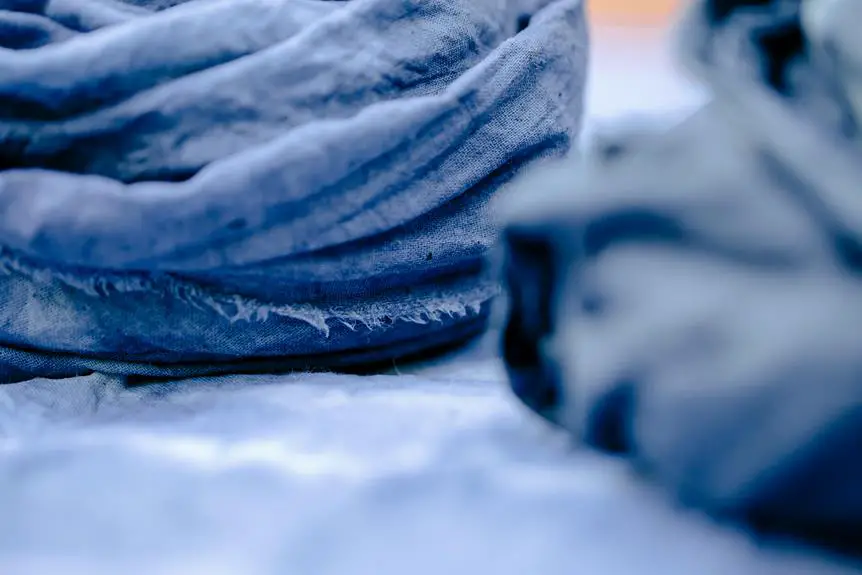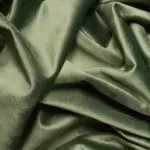If you're looking to add a splash of color to your seersucker fabric, you'll want to start by selecting the right fiber-reactive dye that works well with cotton. Pre-washing your fabric is crucial to ensure the dye adheres properly, so you'll need to take that step before getting started. Once you've got your materials ready, consider the dyeing technique that suits your vision—whether it's a simple dip-dye or something more intricate. But before you proceed, there are a few key aspects about seersucker that can significantly impact your results.
Table of Contents
Understanding Seersucker Fabric
Seersucker fabric, known for its unique puckered texture, is a lightweight cotton that's perfect for warm weather clothing. You'll often find it in summer dresses, shirts, and casual suits, thanks to its ability to keep you cool and comfortable. The fabric's characteristic ripples create air pockets that allow for better airflow, making it ideal for those hot, humid days.
When you touch seersucker, you'll notice its soft feel and slight elasticity. This quality not only enhances comfort but also adds to its charm. Seersucker typically comes in a variety of stripes and patterns, which can elevate any outfit.
If you're considering working with this fabric, keep in mind that its unique texture may affect how it absorbs dye. You should also be aware that seersucker can be more challenging to dye than regular cotton due to its structure. The puckered areas might absorb dye differently than the flat areas, leading to a varied color outcome.
Understanding these properties will help you make informed decisions when you start your dyeing project. So, embrace the quirks of seersucker as you prepare to transform it into something uniquely yours.
Choosing the Right Dye
To achieve the best results when dyeing seersucker, it's important to select a dye that works well with its unique texture and cotton composition. Since seersucker is primarily made of cotton, you'll want to choose a dye specifically formulated for natural fibers.
Fiber-reactive dyes are an excellent choice, as they bond well with cotton and produce vibrant, long-lasting colors.
Consider the type of project you're working on. If you need a specific shade, look for dyes that offer a wide color range or can be mixed to create custom hues. If you're aiming for a more muted or pastel color, direct dyes might be a good alternative, though they may not yield the same intensity as fiber-reactive dyes.
Make sure to check the dye's instructions, as different dyes may require varying methods of application and setting. Additionally, consider whether you prefer liquid or powder dye; both can yield great results, but they might differ in ease of use.
Lastly, don't forget to test the dye on a small fabric swatch first to ensure you're happy with the color before committing to the entire piece.
Preparing the Fabric
Before dyeing, you'll want to thoroughly wash the fabric to remove any finishes or dirt that could affect the dyeing process. Use a gentle detergent and warm water to clean the seersucker fabric. This step will help the dye adhere better, ensuring a more vibrant and even color.
Once the fabric is washed, rinse it well to eliminate any soap residue. It's essential to remove all detergent, as it can interfere with the dyeing process. After rinsing, let the fabric air dry or use a dryer on a low setting, but don't fully dry it. Wet fabric holds dye better, so leaving it slightly damp can be beneficial.
If you're working with a large piece of seersucker, consider cutting it into smaller sections for easier handling. This way, you can dye each piece separately, ensuring consistent results.
You might also want to iron the fabric lightly to remove wrinkles, as this helps in achieving an even dye distribution. Once the fabric is prepared, you're ready to move on to the dyeing techniques that will bring your vision to life.
Dyeing Techniques
Experimenting with different dyeing techniques can transform your seersucker fabric into a vibrant masterpiece. You'll find that each technique offers unique effects, so don't hesitate to explore several options.
Here are four popular dyeing techniques to consider:
- Tie-Dye: This classic method involves twisting and binding sections of fabric before applying dye. The result? A fun, swirling pattern that's perfect for a casual look.
- Shibori: This Japanese technique uses folding, twisting, or bunching the fabric, creating intricate patterns. It's a bit more complex but yields stunning results that can elevate your garment.
- Dip-Dye: With dip-dyeing, you immerse only part of your fabric into the dye bath. This creates a beautiful gradient effect, blending colors seamlessly.
- Block Printing: Use carved stamps to apply dye onto your fabric. This method allows for personalized designs and can be layered for depth and texture.
Choose a technique that resonates with your style, gather your materials, and let your creativity flow. Remember, practice makes perfect, so enjoy the journey of dyeing!
Rinsing and Setting the Dye
Once you've dyed your seersucker fabric, it's crucial to properly rinse and set the dye to ensure vibrant, lasting color.
Start by pre-washing the fabric to remove any residue, then apply a dye fixative to help lock in the color.
Pre-Wash the Fabric
Pre-washing the fabric helps remove any residues that could interfere with the dyeing process, ensuring vibrant and even color results. It's an essential step you shouldn't skip.
Here's how to effectively pre-wash your seersucker fabric:
- Gather Supplies: Collect your fabric, a mild detergent, and a large container or washing machine.
- Wash in Cold Water: Set your washing machine to a gentle cycle using cold water. This helps prevent any shrinkage or damage to the fabric.
- Add Detergent: Use a small amount of mild detergent to clean the fabric. Avoid using fabric softeners, as they can leave a residue that affects dye absorption.
- Rinse Thoroughly: After the wash cycle, rinse the fabric thoroughly in cold water to ensure all detergent is removed.
Once you've completed these steps, your seersucker fabric will be ready for dyeing.
Pre-washing not only enhances the dyeing results but also prepares your fabric for a beautiful transformation.
Now you can move on to the exciting part—dyeing your fabric!
Dye Fixative Application
After you've dyed your seersucker fabric, applying a dye fixative is vital for ensuring the color sets properly and lasts over time. This step helps the dye bond more effectively with the fabric fibers, reducing the risk of fading or bleeding during future washes.
Start by preparing the dye fixative solution according to the manufacturer's instructions. Typically, you'll mix the fixative with water in a large basin or bucket. Once your solution is ready, carefully submerge the dyed fabric into the mixture, ensuring it's fully saturated. Allow it to soak for the recommended time, usually around 15 to 30 minutes, to ensure the fixative penetrates the fibers.
After the soaking period, gently agitate the fabric to help distribute the fixative evenly. Avoid wringing or twisting the fabric, as this can distort its shape. Once you finish soaking, remove the fabric and let it drain for a moment.
You can then proceed to rinse the fabric under cool water to remove any excess fixative. This step will help set the dye, making your vibrant seersucker fabric look great and ready for use!
Rinse Techniques Explained
Rinsing your seersucker fabric properly is crucial for setting the dye and preventing any unwanted color bleeding. After you've applied your dye fixative, it's time to rinse the fabric thoroughly. Here are some essential steps to follow:
- Use Cold Water: Start by rinsing your fabric in cold water. This helps to lock in the dye and aids in preventing it from running.
- Gentle Agitation: Gently agitate the fabric with your hands, ensuring that all areas are rinsed. Avoid wringing or twisting, as this can distort the fabric.
- Repeat Until Clear: Continue rinsing until the water runs clear. This could take several rinses, depending on the dye you used. Don't rush this step; it's important for achieving long-lasting results.
- Set the Dye: After rinsing, set the dye by soaking the fabric in a mixture of cold water and white vinegar for about 30 minutes. This additional step can enhance color retention.
Care Instructions for Dyed Fabric
Now that you've dyed your seersucker fabric, it's essential to know how to care for it properly.
You'll want to wash it with care, iron it correctly, and store it in a way that maintains its vibrant colors.
Let's explore the best practices for keeping your dyed fabric looking fresh and new.
Washing Dyed Seersucker Fabric
To keep your dyed seersucker fabric looking vibrant, always wash it in cold water with a gentle detergent. This will help preserve the color and maintain the fabric's unique texture. Here are some essential care instructions to follow:
- Separate Colors: Always wash your dyed seersucker fabric with similar colors to prevent dye transfer. Mixing with whites or lighter shades can lead to unwanted discoloration.
- Gentle Cycle: Use the delicate cycle on your washing machine to minimize agitation. This protects the fabric from wear and tear, ensuring it lasts longer.
- Avoid Bleach: Never use bleach or harsh chemicals, as they can strip the dye and ruin the fabric. Stick to mild detergents specifically designed for colored fabrics.
- Air Dry: After washing, opt for air drying instead of using a dryer. Hang your fabric in a shaded area to prevent fading from direct sunlight.
Ironing and Pressing Tips
After washing, it's important to properly iron and press your dyed seersucker fabric to maintain its vibrant colors and unique texture.
Start by ensuring the fabric is slightly damp; this helps to reduce wrinkles more effectively. Set your iron to a low to medium heat setting, as high temperatures can damage both the dye and the fabric itself.
Use a pressing cloth, such as a clean cotton cloth or muslin, between the iron and the fabric. This additional layer protects the colors and prevents any shine from developing on the seersucker's surface.
Gently press the iron down without sliding it around; this helps to avoid stretching or distorting the fabric. For tricky areas, like seams or pleats, lift the iron and reposition it as needed, rather than dragging it.
If the fabric has stubborn wrinkles, consider steaming instead of direct contact with the iron. Always test a small, inconspicuous area first to ensure the heat won't harm the fabric.
Lastly, allow the fabric to cool completely before folding or hanging, as this helps preserve its shape and prevents new wrinkles from forming.
Storing Dyed Fabrics Properly
Proper storage of dyed fabrics is essential to maintain their color vibrancy and prevent damage over time. By following a few simple care instructions, you can ensure your dyed seersucker fabric stays looking fresh and beautiful.
Here are four key tips for storing your dyed fabrics:
- Keep it Cool and Dry: Store your fabrics in a cool, dry place away from direct sunlight. Heat and moisture can cause colors to fade or fabrics to mildew.
- Use Breathable Storage: Avoid plastic bags or containers that can trap moisture. Instead, opt for cotton or muslin bags that allow air circulation.
- Avoid Folding Creases: If possible, hang your fabrics on padded hangers to avoid creases. If you must fold, use acid-free tissue paper to prevent impressions.
- Check Regularly: Periodically inspect your stored fabrics for any signs of discoloration or damage. Catching issues early can save your favorite pieces.
Frequently Asked Questions
Can I Dye Pre-Made Seersucker Clothing Instead of Fabric?
Yes, you can dye pre-made seersucker clothing, but results may vary. Make sure to check the fabric content and use a dye suitable for that material to achieve the desired color and maintain quality.
What Types of Dyes Work Best for Seersucker?
For seersucker, you'll want to use fiber-reactive dyes or all-purpose dyes. These options bond well with cotton, ensuring vibrant colors. Just make sure to follow the dyeing instructions for the best results.
How Does Dyeing Affect the Texture of Seersucker?
Dyeing can change seersucker's texture, making it feel softer or stiffer depending on the dye type and method. You might notice a slight difference in the fabric's crinkle, affecting its overall appearance and drape.
Is It Safe to Dye Seersucker in a Washing Machine?
Dyeing seersucker in a washing machine can be safe if you use the right dye and follow instructions carefully. Just make sure to use cold water and avoid mixing with other fabrics to prevent color bleeding.
Can I Mix Different Dye Colors for Unique Patterns?
Yes, you can mix different dye colors for unique patterns! Experimenting with various shades can create stunning effects. Just remember to test on a small fabric piece first, ensuring you're happy with the result before proceeding.
- How Does Ring Spun Cotton Affect Garment Fit and Shape Retention? - August 13, 2024
- What Are the Challenges in Producing Ring Spun Cotton? - August 13, 2024
- Is Ring Spun Cotton Suitable for Plus-Size Clothing? - August 13, 2024







